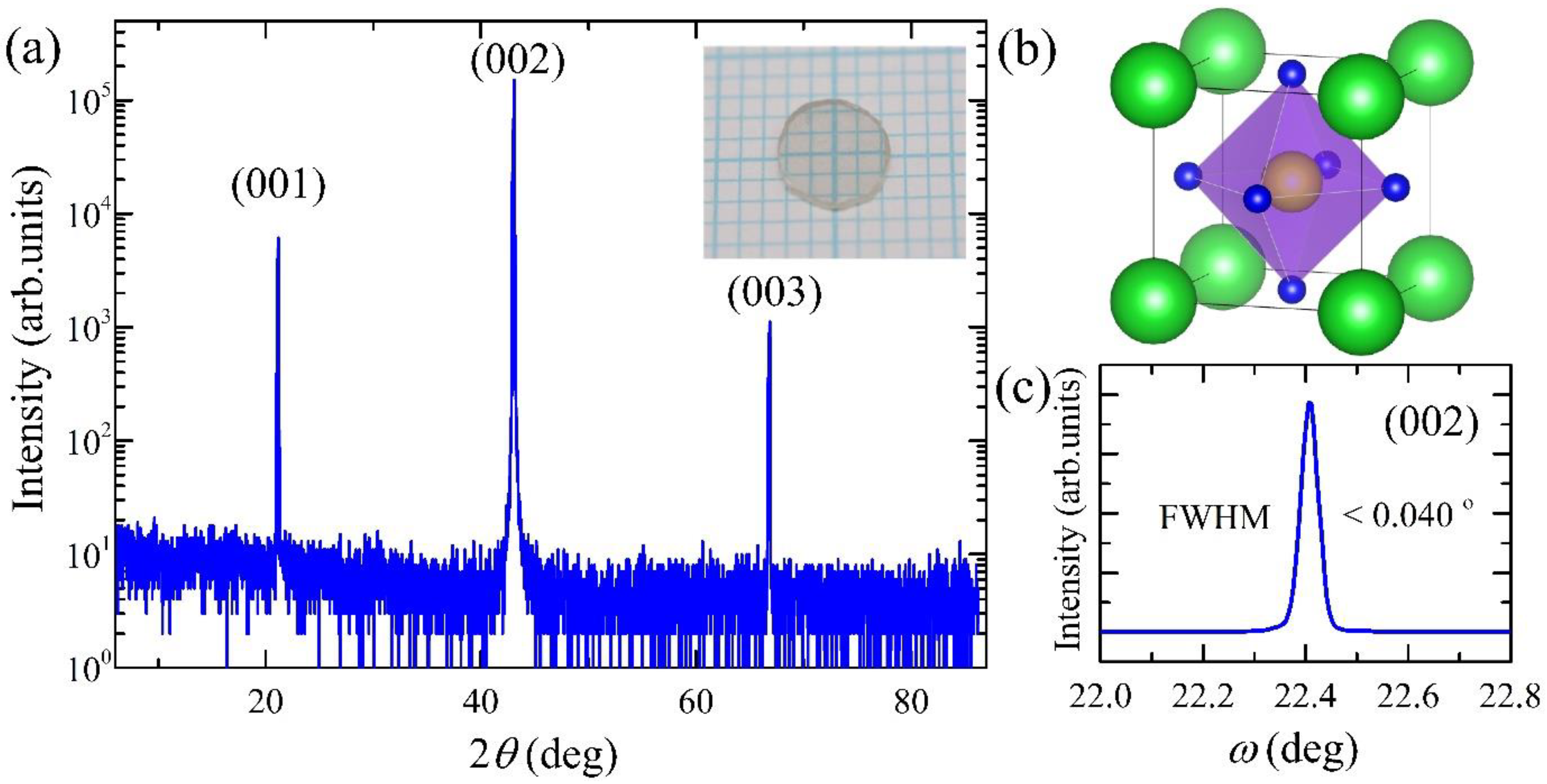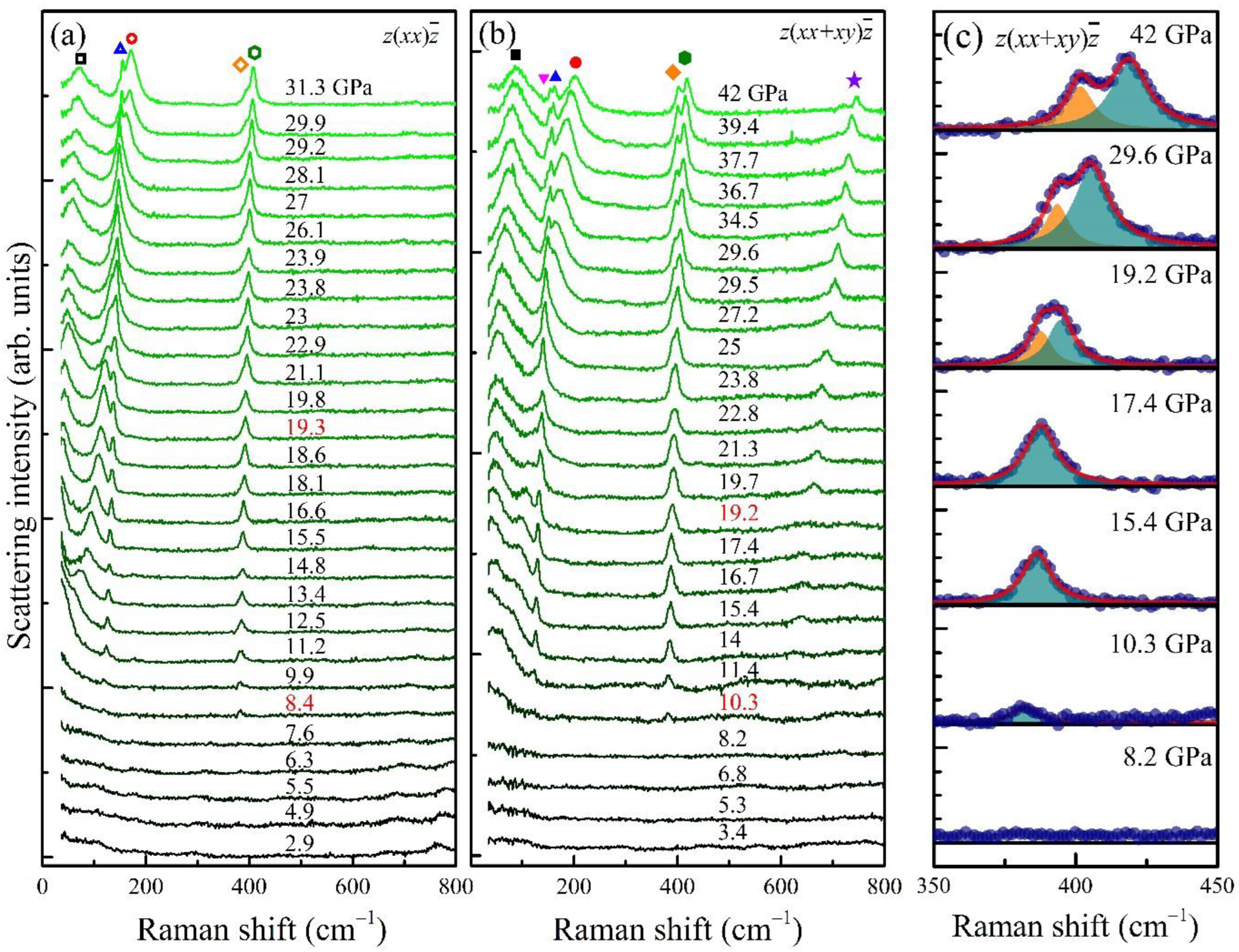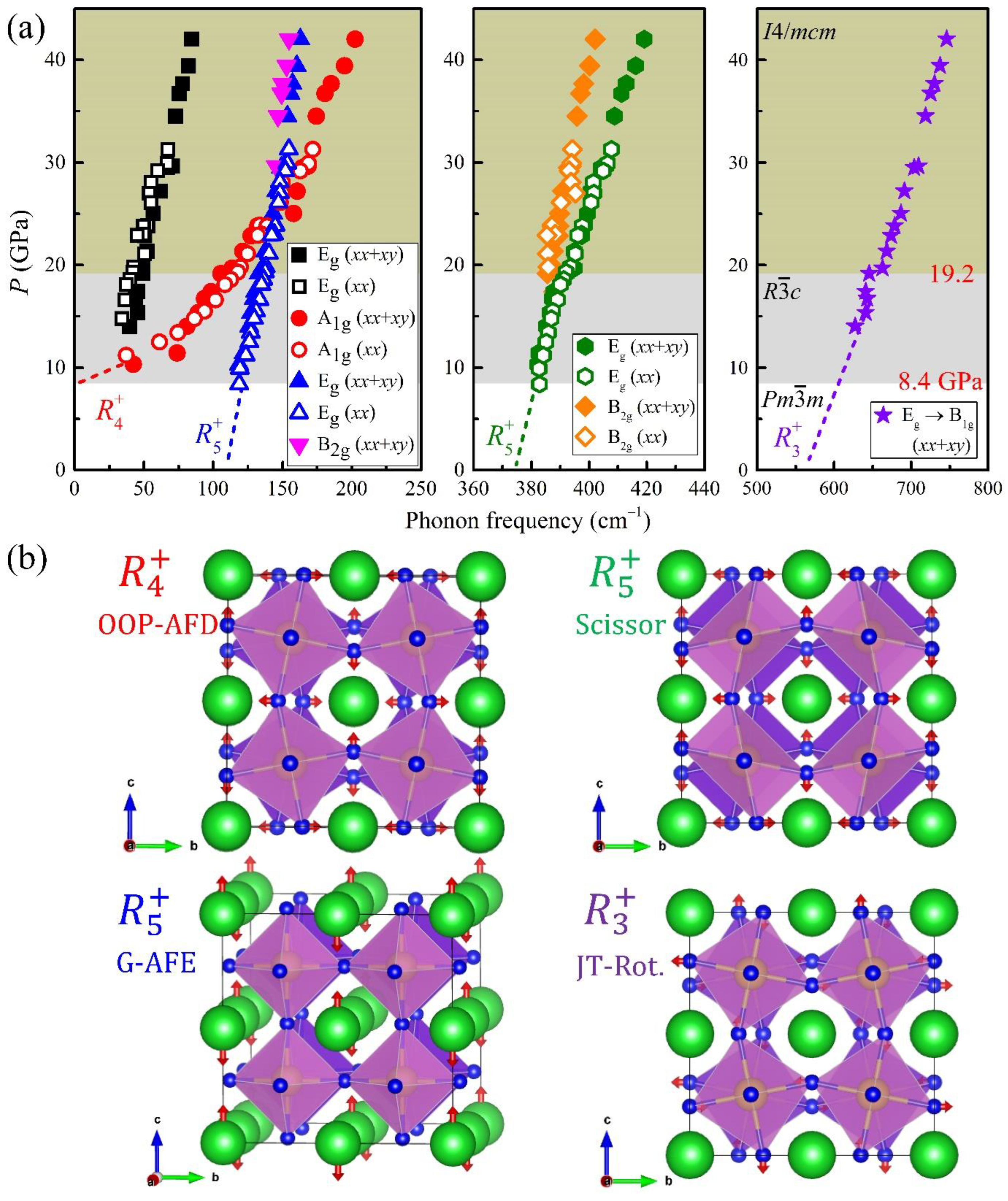Pressure-Dependent Structure of BaZrO3 Crystals as Determined by Raman Spectroscopy
Abstract
:1. Introduction
2. Experimental Methods
2.1. Sample Preparation
2.2. Pressure-Dependent Raman Spectroscopy Experiment
2.3. Infrared Spectroscopy Experiment at the Atmospheric Pressure
3. Results and Discussions
3.1. Vibrational Modes at Ambient Pressure
3.2. Raman Scattering at Higher Pressures
4. Conclusions
Supplementary Materials
Author Contributions
Funding
Institutional Review Board Statement
Informed Consent Statement
Conflicts of Interest
References
- Vassen, R.; Cao, X.; Tietz, F.; Basu, D.; Stöver, D. Zirconates as New Materials for Thermal Barrier Coatings. J. Am. Ceram. Soc. 2000, 83, 2023. [Google Scholar] [CrossRef]
- Liang, R.; Bonn, D.; Hardy, W.N. Growth of high quality YBCO single crystals using BaZrO3 crucibles. Phys. C Supercond. 1998, 304, 105. [Google Scholar] [CrossRef]
- Azad, A.-M.; Subramaniam, S.; Dung, T.W. On the development of high density barium metazirconate (BaZrO3) ceramics. J. Alloys Compd. 2002, 334, 118. [Google Scholar] [CrossRef]
- Roberts, S. Polarizabilities of Ions in Perovskite-Type Crystals. Phys. Rev. 1951, 81, 865. [Google Scholar] [CrossRef]
- Muhsen, K.N.D.K.; Osman, R.A.M.; Idris, M.S. The efects of Ca, Zr and Sn substitutions into a ternary system of BaTiO3–BaSnO3–BaZrO3 towards its dielectric and piezoelectric properties: A review. J. Mater. Sci. Mater. Electron. 2020, 32, 12771. [Google Scholar] [CrossRef]
- Parida, S.; Rout, S.; Cavalcante, L.; Sinha, E.; Li, M.S.; Subramanian, V.; Gupta, N.; Gupta, V.; Varela, J.A.; Longo, E. Structural refinement, optical and microwave dielectric properties of BaZrO3. Ceram. Int. 2012, 38, 2129. [Google Scholar] [CrossRef]
- Pergolesi, D.; Fabbri, E.; D’Epifanio, A.; Di Bartolomeo, E.; Tebano, A.; Sanna, S.; Licoccia, S.; Balestrino, G.; Traversa, E. High proton conduction in grain-boundary-free yttrium-doped barium zirconate films grown by pulsed laser deposition. Nat. Mater. 2010, 9, 846. [Google Scholar] [CrossRef] [Green Version]
- Morejudo, S.H.; Zanón, R.; Escolástico, S.; Yuste-Tirados, I.; Malerød-Fjeld, H.; Vestre, P.K.; Coors, W.G.; Martínez, A.; Norby, T.; Serra, J.M.; et al. Direct conversion of methane to aromatics in a catalytic co-ionic membrane reactor. Science 2016, 353, 563. [Google Scholar] [CrossRef]
- Malerød-Fjeld, H.; Clark, D.; Yuste-Tirados, I.; Zanón, R.; Catalán-Martinez, D.; Beeaff, D.; Morejudo, S.H.; Vestre, P.K.; Norby, T.; Haugsrud, R.; et al. Thermo-electrochemical production of compressed hydrogen from methane with near-zero energy loss. Nat. Energy 2017, 2, 923. [Google Scholar] [CrossRef]
- Chen, X.; Rieth, L.; Miller, M.S.; Solzbacher, F. High temperature humidity sensors based on sputtered Y-doped BaZrO3 thin films. Sens. Actuators B Chem. 2009, 137, 578. [Google Scholar] [CrossRef]
- Akbarzadeh, A.; Kornev, I.; Malibert, C.; Bellaiche, L.; Kiat, J.-M. Combined theoretical and experimental study of the low-temperature properties of BaZrO3. Phys. Rev. B 2005, 72, 205104. [Google Scholar] [CrossRef] [Green Version]
- Zhao, Y.; Weidner, D. Thermal expansion of SrZrO3 and BaZrO3 perovskites. Phys. Chem. Miner. 1991, 18, 294. [Google Scholar] [CrossRef]
- Bilić, A.; Gale, J.D. Ground state structure of BaZrO3: A comparative first-principles study. Phys. Rev. B 2009, 79, 174107. [Google Scholar] [CrossRef] [Green Version]
- Kersch, A.; Fischer, D.J. Phase stability and dielectric constant of ABO3 perovskites from first principles. Appl. Phys. 2009, 106, 014105. [Google Scholar] [CrossRef]
- Bennett, J.W.; Grinberg, I.; Rappe, A.M. Effect of symmetry lowering on the dielectric response of BaZrO3. Phys. Rev. B 2006, 73, 180102. [Google Scholar] [CrossRef] [Green Version]
- Toulouse, C.; Amoroso, D.; Xin, C.; Veber, P.; Hatnean, M.C.; Balakrishnan, G.; Maglione, M.; Ghosez, P.; Kreisel, J.; Guennou, M. Lattice dynamics and Raman spectrum of BaZrO3 single crystals. Phys. Rev. B 2019, 100, 134102. [Google Scholar] [CrossRef] [Green Version]
- Lucazeau, G.J. Effect of pressure and temperature on Raman spectra of solids: Anharmonicity. Raman Spectrosc. 2003, 34, 478. [Google Scholar] [CrossRef]
- Colomban, P.; Slodczyk, A. Raman Intensity: An Important Tool in the Study of Nanomaterials and Nanostructures. Acta Phys. Pol. A 2009, 116, 7. [Google Scholar] [CrossRef]
- Chemarin, C.; Rosman, N.; Pagnier, T.; Lucazeau, G.J. A High-Pressure Raman Study of Mixed Perovskites BaCexZr1−xO3 (0 ≤ x ≤ 1). Solid State Chem. 2000, 149, 298. [Google Scholar] [CrossRef]
- Loudon, R. Theory of the first-order Raman effect in crystals. Proc. R. Soc. A 1963, 275, 218. [Google Scholar]
- Helal, M.; Kojima, S. Structural instability and phase transition in BaZrO3 single crystals: Brillouin scattering and DFT study. Mater. Sci. Eng. B 2021, 271, 115314. [Google Scholar] [CrossRef]
- Sekine, T.; Uchinokura, K.; Matsuura, E. Raman scattering from two-phonon resonance states in SrTiO3. Solid State Commun. 1976, 18, 569. [Google Scholar] [CrossRef]
- Perry, C.; Fertel, J.H.; McNelly, T.J. Temperature Dependence of the Raman Spectrum of SrTiO3 and KTaO3. Chem. Phys. 1967, 47, 1619. [Google Scholar] [CrossRef]
- Perrichon, A.; Jedvik Granhed, E.; Romanelli, G.; Piovano, A.; Lindman, A.; Hyldgaard, P.; Wahnstrom, G.; Karlsson, M. Unraveling the Ground-State Structure of BaZrO3 by Neutron Scattering Experiments and First-Principles Calculations. Chem. Mater. 2020, 32, 2824. [Google Scholar] [CrossRef] [Green Version]
- Granhed, E.J.; Wahnström, G.; Hyldgaard, P. BaZrO3 stability under pressure: The role of nonlocal exchange and correlation. Phys. Rev. B 2020, 101, 224105. [Google Scholar] [CrossRef]
- Chen, P.; Grisolia, M.N.; Zhao, H.J.; González-Vázquez, O.E.; Bellaiche, L.; Bibes, M.; Liu, B.-G.; Íñiguez, J. Energetics of oxygen-octahedra rotations in perovskite oxides from first principles. Phys. Rev. B 2018, 97, 024113. [Google Scholar] [CrossRef] [Green Version]
- Lebedev, A.; Sluchinskaya, I. Combined first-principles and EXAFS study of structural instability in BaZrO3. J. Adv. Dielectr. 2015, 5, 1550019. [Google Scholar] [CrossRef] [Green Version]
- Yang, X.; Li, Q.; Liu, R.; Liu, B.; Zhang, H.; Jiang, S.; Liu, J.; Zou, B.; Cui, T.; Liu, B. Structural phase transition of BaZrO3 under high pressure. J. Appl. Phys. 2014, 115, 124907. [Google Scholar] [CrossRef]
- Petzelt, J.; Ostapchuk, T.; Gregora, I.; Rychetsky, I.; Hoffmann-Eifert, S.; Pronin, A.; Yuzyuk, Y.; Gorshunov, B.; Kamba, S.; Bovtun, V.; et al. Dielectric, infrared, and Raman response of undoped SrTiO3 ceramics: Evidence of polar grain boundaries. Phys. Rev. B 2001, 64, 184111. [Google Scholar] [CrossRef]
- Jang, H.; Kumar, A.; Denev, S.; Biegalski, M.D.; Maksymovych, P.; Bark, C.; Nelson, C.T.; Folkman, C.; Baek, S.H.; Balke, N.; et al. Ferroelectricity in Strain-Free SrTiO3 Thin Films. Phys. Rev. Lett. 2010, 104, 197601. [Google Scholar] [CrossRef] [Green Version]
- Xin, C.; Veber, P.; Guennou, M.; Toulouse, C.; Valle, N.; Hatnean, M.C.; Balakrishnan, G.; Haumont, R.; Saint Martin, R.; Velazquez, M.; et al. Single crystal growth of BaZrO3 from the melt at 2700 °C using optical floating zone technique and growth prospects from BaB2O4 flux at 1350 °C. Cryst. Eng. Comm. 2019, 21, 502. [Google Scholar] [CrossRef] [Green Version]
- Shen, G.; Wang, Y.; Dewaele, A.; Wu, C.; Fratanduono, D.E.; Eggert, J.; Klotz, S.; Dziubek, K.F.; Loubeyre, P.; Fat’yanov, O.V.; et al. Toward an international practical pressure scale: A proposal for an IPPS ruby gauge (IPPS-Ruby2020). High Press. Res. 2020, 40, 299. [Google Scholar] [CrossRef]
- Mazzei, L.; Rukser, D.; Biebl, F.; Grimm-Lebsanft, B.; Neuber, G.; Pergolesi, D.; Börjesson, L.; Rübhausen, M.A.; Andreasson, J.; Karlsson, M.J. Phonon spectra of pure and acceptor doped BaZrO3 investigated with visible and UV Raman spectroscopy. Phys. Condens. Matter 2020, 32, 405403. [Google Scholar] [CrossRef] [PubMed]
- Shi, F.; Dong, H.; Liu, Q.; Yang, J.; Ren, S.; Sun, H.; Xiong, J. Investigation and theoretical calculation of the lattice vibrational spectra of BaZrO3 ceramic. J. Mater. Sci. Mater. Electron. 2017, 28, 3467. [Google Scholar] [CrossRef]
- Nuzhnyy, D.; Petzelt, J.; Savinov, M.; Ostapchuk, T.; Bovtun, V.; Kempa, M.; Hlinka, J.; Buscaglia, V.; Buscaglia, M.; Nanni, P. Broadband dielectric response of Ba(Zr,Ti)O3 ceramics: From incipient via relaxor and diffuse up to classical ferroelectric behavior. Phys. Rev. B 2012, 86, 014106. [Google Scholar] [CrossRef]
- Stokes, H.T.; Kisi, E.H.; Hatch, D.M.; Howard, C.J. Group-theoretical analysis of octahedral tilting in ferroelectric perovskites. Acta Crystallogr. B Struct. Sci. 2002, 58, 934. [Google Scholar] [CrossRef] [Green Version]
- Howard, C.J.; Stokes, H.T. Group-Theoretical Analysis of Octahedral Tilting in Perovskites. Acta Crystallogr. B Struct. Sci. 1998, 54, 782. [Google Scholar] [CrossRef] [Green Version]
- Loudon, R. General Space-Group Selection Rules for Two-Phonon Processes. Phys. Rev. 1965, 137, A1784. [Google Scholar] [CrossRef]
- Burns, G.; Dacol, F. Lattice modes in ferroelectric perovskites. III. Soft modes in BaTiO3. Phys. Rev. B 1978, 18, 5750. [Google Scholar] [CrossRef]
- Husson, E.; Abello, L.; Morell, A. Short-range order in PbMg1/3Nb2/3O3 ceramics by Raman spectroscopy. Mater. Res. Bull. 1990, 25, 539. [Google Scholar] [CrossRef]
- Celeste, A.; Borondics, F.; Capitani, F. Hydrostaticity of pressure-transmitting media for high pressure infrared spectroscopy. High Press. Res. 2019, 39, 608. [Google Scholar] [CrossRef]
- Klotz, S.; Chervin, J.-C.; Munsch, P.; Le Marchand, G.J. Hydrostatic limits of 11 pressure transmitting media. Phys. D Appl. Phys. 2009, 42, 075413. [Google Scholar] [CrossRef]
- Xiang, H.; Guennou, M.; Íñiguez, J.; Kreisel, J.; Bellaiche, L. Rules and mechanisms governing octahedral tilts in perovskites under pressure. Phys. Rev. B 2017, 96, 054102. [Google Scholar] [CrossRef] [Green Version]
- Benedek, N.A.; Fennie, C.J. Why Are There So Few Perovskite Ferroelectrics? J. Phys. Chem. C 2013, 117, 13339. [Google Scholar] [CrossRef] [Green Version]




| Polycrystal Raman Shift | Single Crystal Raman Shift | Single Crystal IR Mode | Zone-Boundary Phonon (DFT) | Assignment |
|---|---|---|---|---|
| (Figure 2a) | (Figure 2b) | (Figure 2d) | [24,25] | |
| 179 | - | (Ba) | ||
| 199 | 189 | (O6) | ||
| 248 | - | 2TO1 | ||
| 280 | 276 | 2LO1 | ||
| 348 | 343 | TO1+TO2 | ||
| 392 | - | LO2 | ||
| 444 | 447 | 2TO2 | ||
| 473 | - | (Ba,O6) | ||
| 588 | 584 | (O6) | ||
| 637 | 639 | TO1 + TO3 | ||
| 738 | 738 | TO2 + TO3 | ||
| 842 | 843 | LO1 + LO3 | ||
| 1017 | 1013 | 2TO3 | ||
| 123 | TO1 (Ba–O) | |||
| 144 | LO1 (Ba–O) | |||
| 217 | TO2 (Zr–O) | |||
| 398 | LO2 (Zr–O) | |||
| 516 | TO3 (O–O) | |||
| 701 | LO3 (O–O) | |||
| 48 | (O6, OOP-AFD) | |||
| 87 | (Ba, A-AFE) | |||
| 95 | (O6, IP-AFD) | |||
| 106 | (Ba, G-AFE) | |||
| 373 | (O6, Scissor) | |||
| 545 | (JT-Rot.) |
Publisher’s Note: MDPI stays neutral with regard to jurisdictional claims in published maps and institutional affiliations. |
© 2022 by the authors. Licensee MDPI, Basel, Switzerland. This article is an open access article distributed under the terms and conditions of the Creative Commons Attribution (CC BY) license (https://creativecommons.org/licenses/by/4.0/).
Share and Cite
Gim, D.-H.; Sur, Y.; Lee, Y.H.; Lee, J.H.; Moon, S.; Oh, Y.S.; Kim, K.H. Pressure-Dependent Structure of BaZrO3 Crystals as Determined by Raman Spectroscopy. Materials 2022, 15, 4286. https://doi.org/10.3390/ma15124286
Gim D-H, Sur Y, Lee YH, Lee JH, Moon S, Oh YS, Kim KH. Pressure-Dependent Structure of BaZrO3 Crystals as Determined by Raman Spectroscopy. Materials. 2022; 15(12):4286. https://doi.org/10.3390/ma15124286
Chicago/Turabian StyleGim, Dong-Hyeon, Yeahan Sur, Yoon Han Lee, Jeong Hyuk Lee, Soonjae Moon, Yoon Seok Oh, and Kee Hoon Kim. 2022. "Pressure-Dependent Structure of BaZrO3 Crystals as Determined by Raman Spectroscopy" Materials 15, no. 12: 4286. https://doi.org/10.3390/ma15124286






